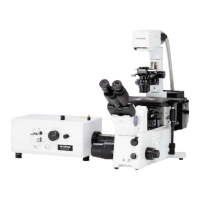Getting Started FLUOVIEW/Basic Operations
IV.
OPERATION INSTRUCTIONS
IV .
1-15
Page
(1) Light path selector button
Select the light path between laser microscopic observation and direct observation.
x When LED is illuminated, the light path is switched for laser microscopic
observation.
x When LED is not illuminated, the light path is switched for direct observation.
(2) Fluorescence mirror unit
Select the fluorescence observation tube by rotating the turret.
x Engage the desired cube in the light path for direct fluorescence observation.
x For laser microscopy or for direct transmitted light observation, rotate the
turret to page tab
. (This set the turret so that no cube is engaged.)
(3) Analyzer IX2-MDICT (optional)
Polarizing plate for use in differential interference observation and polarized light
observation.
x Rotate the cube turret to engage the IX2-MDICT analyzer into the light path
for direct transmitted light differential interference observation or transmitted
polarized light observation.
x Be sure to disengage the IX2-MDICT analyzer for laser microscopy. Engaging
the IX2-MDICT analyzer into the light path allows the acquired image quality to
improve.
(4) Transmitted light DIC slider U-DICTS (optional)
This is the prism for use in differential interference observation.
x Engage U-DICTS in the light path for laser differential interference
observation or direct transmitted light differential interference observation.
Leaving U-DICTS engaged during laser fluorescence observation will degrade
the image quality somewhat. We recommend disengaging U-DICTS from the
light path when simple laser fluorescence observation is required.
With transmitted light differential interference observation using
an immersion objective, set the microscope’s field diaphragm so
that it inscribes the field of view. Otherwise the contrast may
degrade. (This applies to both direct observation and laser
differential interference observation.)
NOTE

